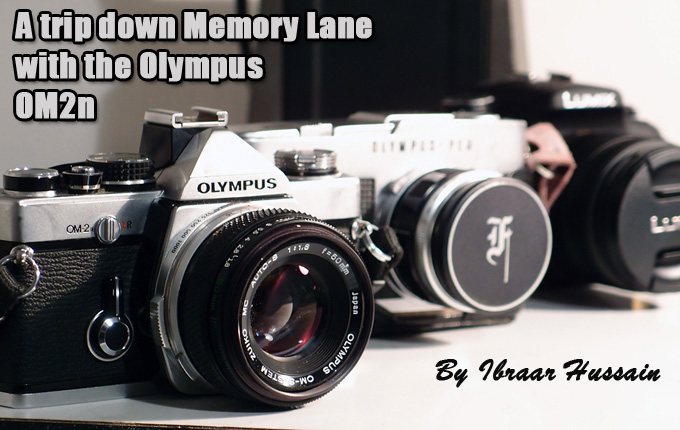
To celebrate the release of the new Olympus OM-D I thought I’d take everyone for a trip down memory lane with a selection of snaps from my precious Olympus OM2n with the Zuiko MC 50mm f1.8 lens For those who haven’t had the pleasure of handling the OM2n, it’s a gem of a camera.
The OM philosophy was (and now is again) (in my own words) to create a high quality, beautifully engineered, precision photographic instrument with sharp quality optics in a compact size. The OM2n is certainly that.
The OM2n runs on a small watch type battery which lasts for years – this powers the (fairly accurate) meter and enables Aperture Priority operation, It’s widely available and isn’t one of the more sought out versions of the single digit OM series,That honour lies with the OM3Ti which is a fully mechanical camera and as rare as hens teeth!
The most advanced version is the OM4 and OM4Ti, these feature a revolutionary multi spot metering system which was and is highly regarded.
What I love about this camera is the fact that it looks superb and feels superb, strolling around the streets of London with it in my hand and around my neck, winding the film crank, and hearing the satisfying trip of the shutter, it attracts a lot of attention, it oozes class and sophistication, something Leicaman thinks is exclusive to him, but us Olympians know better!
The optics are also readily available, check out http://www.ffordes.co.uk who are brilliant when it comes to used camera equipment at bargain prices. I just love the Zuiko lenses, they’re small, compact, beautifully made and are a joy to use and focus smoothly, and most importantly produce crisp, contrasty pin sharp results (if you have decent eye sight as they’re all manual focus).
Well, if you’re used to Auto focussed fast DSLR’s with tunnel like viewfinders, or Micro 4/3rds compacts, or even Range Finders with quirky focussing – you’ll be surprised and pleased with using and playing with the OM series, with the HUGE bright View Finder (the only 35mm sized camera I’ve ever seen or used with a larger brighter Finder than this huge one on the OM is the peerless VF on the Contax Aria) the SLR design, and i’m going to get a LOT of flak for this, is better than a Range Finder design for making photographs and visualising – as you see what the lens see’s! (my personal opinions, so feel free to disagree).
For those purchasing the OM-D who have never used a classic OM – they’re affordable and worth investing in! You’ll be pleasantly surprised at the beauty and bright view finder, and for those complaining that Micro 4/3 cannot get you the shallow depth of field an APS-C or full Frame gives you, well, the 35mm Film is larger than either, so you’ll get as much shallow depth as you like!
Anyway, is the OM series worth getting in this day and age? Yes it is, as for the price of a cheap digital compact you can possess a beautifully made SLR with tack sharp lenses, which will serve you for many decades to come.
–
–
Coffee Break. Fuji Neopan 400 50mm Zuiko f1.8
–
Kids At the Beach, 50mm f1.8 Agfa Precisa 100
–
–
–
Three is Company. Sheep under the full moon at dusk, Brecon Beacons. Kodak tri X 400, hand held. 50mm Zuiko f1.8 (cropped)

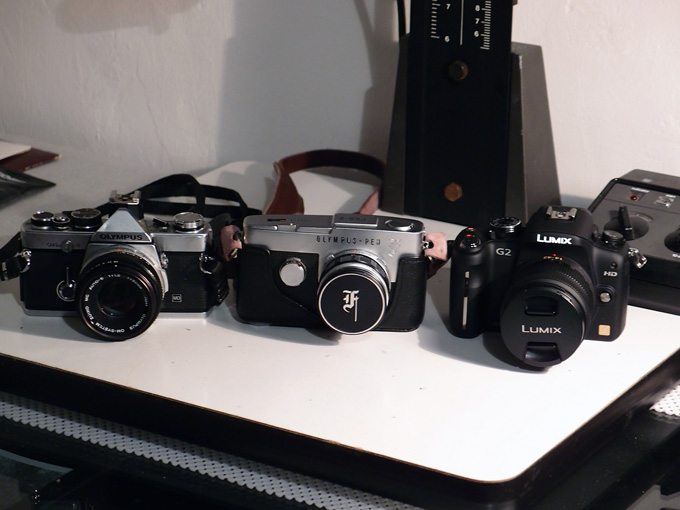
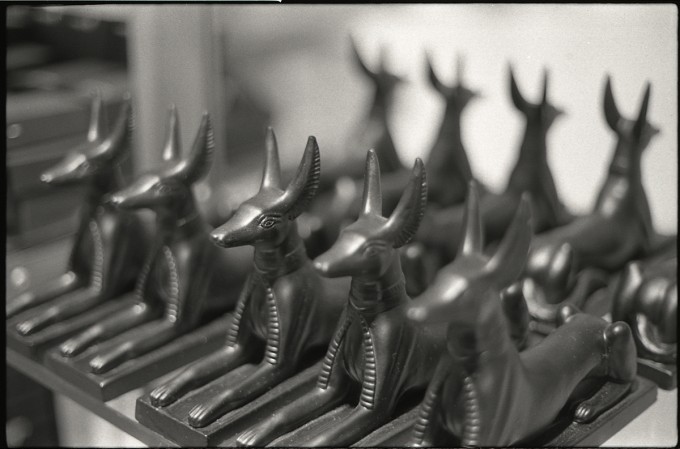
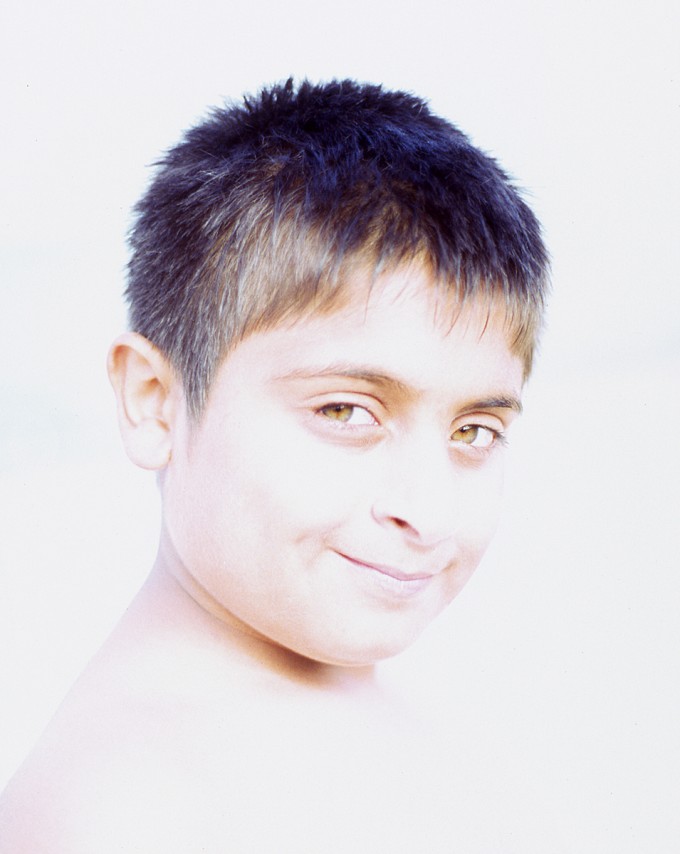
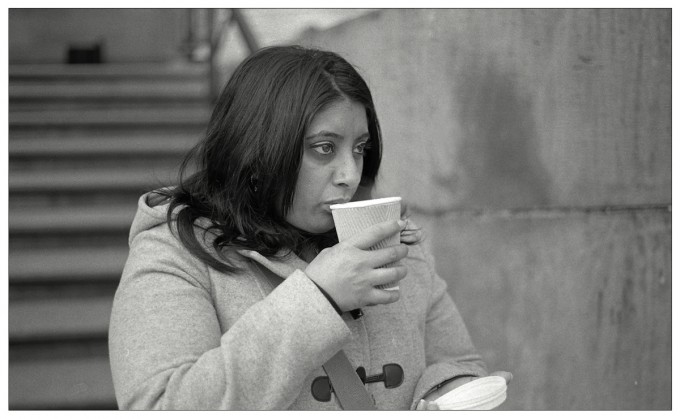

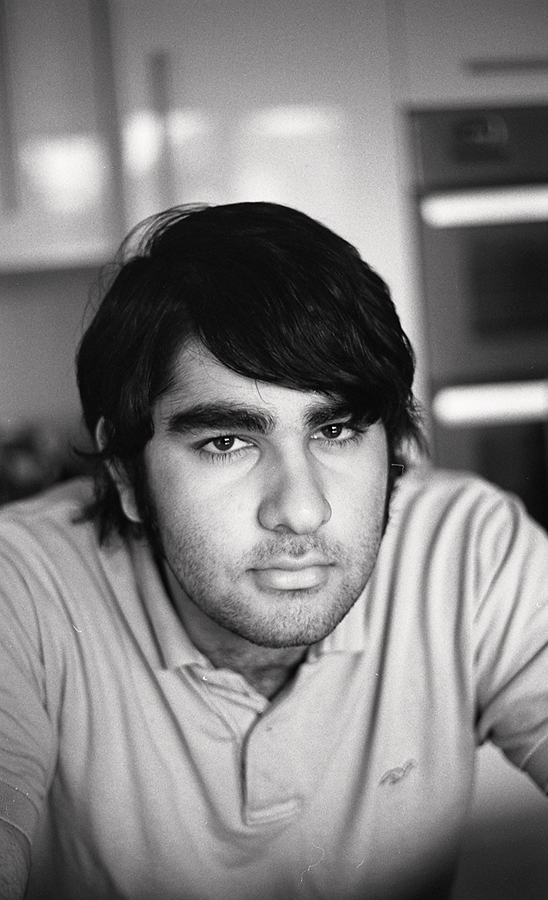
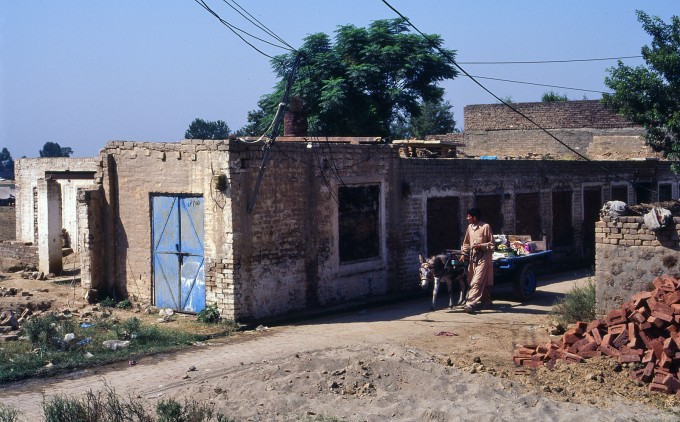

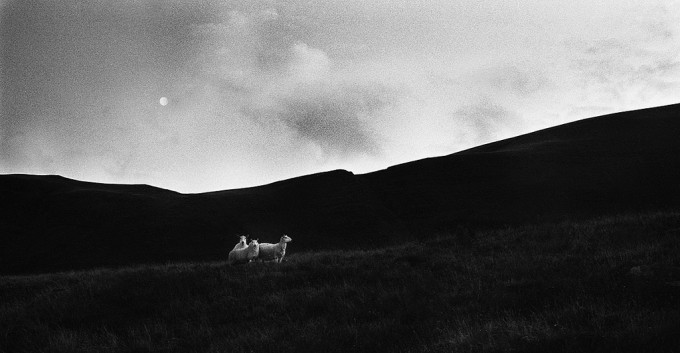


That the Olympus OM series cameras and lenses are still very good today speaks volumes for the integrity of design and quality of manufacture. I’ve never had them. For many years until I got a legacy in 2007, I used Nikon F. Plain prism, one chrome, one black. Still have them. Yes, they are heavy and I used a Weston Master V then a Gossen Lunalite for metering with 28/35/50/85/105/135 lenses. Still have them so pointless me buying Olympus OM gear. But they would be far lighter to carry. I am saddened at the deprecating remarks advanced about Leica M. When circumstances allowed, I first bought a double-stroke M3 then a single stroker. I bought M3 as it had frames in the viewfinder for 50/90/135mm. But first I bought the 35mm f2.8 Summaron lens with the ‘spectacles’ attachment that reduces the magnification in the finder to convert the 50mm frame to 35mm. I then bought a 50mm f2.8, 90mm f2.8 and the 135mm f4.5. I usually just carry the 35/50/90 lenses. I bought a Gossen Sixtomat Digital meter that takes 1 AA battery. I bought a leather ‘Rockley’ bag from Mulberry and constructed an insert to hold 1 M3 body and the 3 lenses and meter, films and filters. This is not a lightweight outfit, however, over the ensuing years I’ve taken it all over the world carrying this bag onto the plane. Despite my single stroke M3 being made in 1960 and my lenses dating 1956-62, I have had no problems at all. The Monochrom? Yes, its a gimmick. I use Ilford XP2 and Kodak BW400CN both chromogenic films, developed and scanned to CD. So, my ancient outfit becomes a digital camera! Unless you have handled and shot with a Leica M, please do not post spiteful comments. They do not suit everyone and there are issues around framing and parallax. However, we range/viewfinder camera users feel a much keener sense of involvement and connection with our subjects. SLR cameras compliment the M cameras, none replaces the others.
My first SLR was a Praktica V, which would have been good as a boat-anchor, then I got a lovely little Pentax SP1000. But when I laid my hands on an Olympus OM-1n – that was an absolute revelation. So light, compact, easy to hold and use – but still utterly reliable, rugged (and feeling rugged too!). Later I got an OM-2SP, but now my ex has it (she prefers the Spot Program metering, I prefer the 1n’s simpler approach). There has never been a 35mm SLR like it for quality, strength and ergonomics.
And the Zuiko lenses – particularly the 50mm f/1.8 (never tried the f/1.4 or f/1.2) – were brilliant. The Takumar SMC f/1.8 was pretty good, but the crispness of the Zuiko was (and is) absolutely smashing.
I just can’t understand the attractions of rangefinders – Leica Ms are for collectors, not photographers – and there’s no point in paying extra just for the name of a Nikon (etc.) when the quality and reliability of the OMs (and their Zuiko lenses) is at least as good. Okay, I also have a Mamiya RB67 system; but for the art, and the sheer fun, of 35mm photography the Olympus OM series still can’t be beaten. Wonderful little machines!
Last year I bought an Olympus OM2n camera with a 28-50mm Tamron lense. Mainly because had aquired a Miranda 70-210mm macro with OM fittings. What am short of are the basic instructions to get me moving. At this moment don’t want to start spending on manuals over the Net which may not be the right ones. So am appealing to any OM photographers out there who could help. 35mm is still my first option in photography and will be as long as film is available though have a Panasonic Digital when feeling lazy.
Look forward to any help you can offer. Many thanks.
Wow! Great photos, Ibraar!
I’m getting the film itch. If you were suggesting ONE or TWO OMs to start with which would they be?
Really inspiring photos…thanks!
My Olympus OM2n has now been sold. Alas, but I’m on the lookout for an OM4Ti
Thanks for the story. We OM shooters have experienced a bit of notice lately. There are articles like this nice one, but everyone is writing about this wonderful camera. I have been shooting an OM-1n (black) since 1979. I now have two OM-1n’s, a chrome OM-2n and an OM-4. They are such wonderful cameras and the glass is amazing (might explain why I have 5 50mm lenses). A large collection of my OM-1 photos can be seen here http://flic.kr/s/aHsjaMskur and OM-2 here http://flic.kr/s/aHsjpAeoNN. If someone feels like they need an OM-2, let me know, I think I have too many film cameras.
Hi Ibraar,
When I was a student at uni some 20+ years a go, I almost bought a used OM2n but unfortunately it had metering problem on the unit that I wanted to buy. So I bought a used Nikon FE instead (which I still keep it till now).
Too bad, Olympus was not famous brand in my country, Indonesia, and difficult to find one in the past.
But you are right, OM2n is a beauty, especially mated with 50mm/1.4 Zuiko lens (I saw 50mm/1.8 on your picture).
Love the “Olympus OM Monochrome!”
Makes you realise how stupid the Leica Monochrome is for the vast majority of us,
OM camera + Lens = £129
& you still have £18,000 left for dark room equipment, film, chemicals, printing paper and a tremendous amount of travel!
true say man! Leica monochrome….mmmmm. I wonder how many mugs will waste their money on one?
Harry, thanks man, digital is basically turned into a method for milking consumers.
if camera makers had any consideration they’d make a camera with a user upgradeable sensor and a standard sensor type ie, m4/3 or a canon apsc or FF. instead we have 5 yr old obsolete cams worth nowt. remember how much the M8 was when released? or nikon d2x? and now??
I’m putting my OM-2n Monochrom on eBay.
Buy-It-Now for $3400. Comes with a roll of Tri-X.
Much more valuable than the color model.
Thanks for the inspiration, Ibraar. It’s nice to read about something other than the camera-of-the-week, which is what digital has become.
Found a nice little OM blog;
http://omexperience.wordpress.com/
Thanks for the refer (omexperience is my blog). You have great pictures here from your OM’s!
My biggest regret is that I have so little time to scan film anymore, so I have now mostly moved over to the OM-D E-M5 which I just got earlier in the week (so it is still technically OM experience). So most of my original OM gear is now gone. However, I still have an OM-1, Zuiko 24/2.8, 50/1.4 and 1.8, 85/2 and 100/2.8 as well as a couple of sigma long telephotos. The later for adapter use, the Zuikos to use on my OM-1.
I’d still be interested in getting a few pieces I never managed to acquire to get for both film use and with adapters, like the Zuiko 50/1.2 and 100/2.
Just wanted to thank everyone for their comments, stories and thoughts!
And to those not yet acquainted with the OM1/2/3/4 series – grab one while you can!
The best ones to get are the purely mechanical ones such as the OM1, OM2 and OM3.
I’d also love to see articles by guys here of their experiences with other mechanical Greats such as the Nikon F or other Nikons 35mm SLR’s
Same old story here, had the OM1, the OM2 and the OM4 back in the day, sold the lot to buy digital, a familiar story. Well a couple of years ago I went on a tour to Afghanistan with the British army and wanted a ‘bullet proof’ camera to take with me. A quick search on eBay and a OM2sp in black was mine, £150 with a cracking 50mm 1.8 lens.
That camera stayed in a pouch on my body amour for 6 months, got bashed around, covered in dust and never let me down once.
Now I’ve got some amazing pictures to remind me of that tour, and I still use the camera still every week. There is something tactile about them, the time to compose a picture, to focus and think about what you’re doing – great review!
To see some of the images from the camera feel free to check out my page on the camera here – http://www.meheux.co.uk/OLYMPUS-OM2SP.html
Brent, superb review man, every point you made was well thought out and justified!
And great pictures too!
Mechanical cameras belong in war zones, like Don McCullin’s Nikon F complete with 7.62mm bullet hole!
Irony ..irony! ..Don McCullin used Olympus OMs in Vietnam. Instead of the weight of big Nikons round his neck, he used OMs as they were so much smaller and lighter – though some professionals called them “ladies’ cameras”, but perhaps that was because Jane Bown (the ‘Observer’ newspaper’s portrait photographer) used one. (She kept it in her shopping basket.)
McCullin made a special trip to personally thank Mr Maitani for having made those revolutionary OMs, which had made his life as a photographer so much easier:
http://www.olympus-global.com/en/corc/history/lecture/lecture2/part9.html
More about Mr Maitani himself:
http://www.olympus-global.com/en/corc/history/lecture/lecture2/part17.html
David, thanks for that man, I had absolutely no idea, I assumed McCullin was a Nikon and Mamiya man! Now I know better! He is absolutely my favourite photographer, no one in my opinion manages to capture the human soul as much as he can, and no one is able to capture the soul of nature as he does with his landscapes in ‘Open Skies’.
So he was an OM man? I will read those articles! thanks again! Any more info as to what his darkroom methods are – printing etc I would love to know. And what did he use to photograph his Open Skies and his Southern frontiers?
great article! thanks man!
“..Any more info as to what his darkroom methods are..”
4th paragraph down, here:
http://www.guardian.co.uk/artanddesign/2005/aug/06/photography.art
That’s rather unusual, as so many photographers have, or had, their printing done by others. Adrian Whatsisname was a favourite in the late seventies and eighties: there were many printers who specialised in simply printing (..interpreting..) well-known photographers’ work.
(..I’ll think of Whatsisname’s name in a minute ..Unwin? No.. er..)
Patrick Lichfield had the tiniest cubbyhole under the stairs where his assistants printed his b&w pictures, and kept his chemicals in ancient medicine bottles with old corks in the top!
“Ensor”! ..Adrian Ensor:
http://www.adrianensor.com/biography.html
Ibraar, I’ve got a reply to you still “..awaiting moderation” (because I put a couple of links in the post, and this software waits for Steve to approve a post which has external links), but meanwhile, if you’re so keen on Don McCullin, why not Google him – you’ll find a contact email or number – and ring him?
See if you can go down there (Somerset) and see if he’ll show you his darkroom and his printing. One of the links in the post that’s “awaiting moderation” is to Adrian Ensor ..another great printer ..and he’s in the middle of London; you wouldn’t have to go far. He even runs printing workshops. With your dedication, you’d love experiencing either (both) of those men print.
Adrian’s work – like any first class printer – is a ballet of the hands; dodging and burning ..and, of course, it has to be done in “real time”: with Photoshop you can take as long as you like to adjust a print. With chemical printing, you’ve only got as long as the light’s on in the enlarger ..10 or 15 seconds, say.
You look at the neg, decide what you’re going to do with it, put it in the holder, switch on the light, and “dance” your hands all over the paper, and in the space between the enlarger head and the paper, till you’ve “burned-in” the sky, “dodged out” the faces, lightened and darkened the print by flicking your fingers over the (..”inside-out” projected-negative..) picture, then you wait for it to emerge after you’ve slid it into the bath of developer.
There’s as much as – or more – “creation” in the printing as in the shooting.
Thanks Dave, ive some reading to do now and its al worth a look. Ive looked over the net and havent found anything about McCullins technique or practises but have t thought about contacting him. Ive read his biography, which is a good read and have most of his books but still no idea about his darkroom technique apart from the fact that he prints dark
Don McCullin:
http://www.bbc.co.uk/radio3/johntusainterview/mccullin_transcript.shtml
Ibraar,
The 7.62mm is an extremely effective anti-camera round.
I used to own a Leica M3 with similar damage. Luckily, I was not behind the camera when the damage was sustained.
hahaha!!! Come on, you’ve just got to TELL that story – what happened???
Lovely review
Well, I’m late to this post, but having recently purchased both OM1 and OM2n ( my dear old Dad’s camera) I just had to take a minute to thank you for the trip down memory lane. Try the 28mm Oly lens…fantastic! Thanks again for the post!
Just last week I went to my local camera repair shop and held an OM-1 in my hand and fell in love instantly. People talked badly about manual focus SLRs, but they never said anything about the “shimmer” effect that assists in focus, or the split image in the middle.
Long story short I ended up tracking one down the next day and was shooting by the next! I love my M6 but honestly I am smitten with the Oly. I love the viewfinder and being able to accurately compose without worrying about parallax, as I am one who likes to meticulously frame my shots. It is also nice seeing through the 1.4 aperture rather than a rangefinder window which won’t show DoF.
That said, I can operate my M faster, and love the Leica shutter “thuft” sound that is so quiet but satisfying.
When I got back my first roll and saw the great images I looked sheepishly at my $3500 Leica combo. I will continue to delude myself and love my M but now there is a solid place in my line-up for the OM, especially in harsh environments where I can’t baby the camera (as a ding in an M causes $100 lost resale value!)
Put a 90mm lens on an M6, and the viewfinder shows what’s seen by ..a 28mm lens.
Put a 90mm (or an 80mm macro) on an OM, and the viewfinder shows what’s seen by.. a 90mm lens (or an 80mm macro). What you see is absolutely what you get.
To put a polariser on an M6: hold up the filter and turn it till the sky looks dark, then fit it to the lens, hoping that it’s in the roughly the same position as when you held it up.
To put a polariser on an OM: fit it on the lens, and turn till the sky darkens.
I cannot understand some people’s obsession with Leicas: they’re small and quiet, but whatever lens you put on it, you see the view seen by a 28mm lens. The OMs are small and quiet, they show you what the lens sees, and only what that lens sees. Choose – and view – your depth of field. See what different filters, or lens hoods, do.
Leica too – or back when they were Leitz – used to make single lens reflexes. But they grew into huge, heavy, massive, lumbering monster SLRs ..nothing like the svelte, sweet, swift, sublime OM.
I can’t understand why digital M’s are so expensive, I can understand the expense and attraction of a 35mm M, as they’re so well crafted, engineered, German made and have very high residuals – like a classic Submariner – but Digital M’s?
I mean they’re electronic gadgets! they’ll be obsolete in a year or two, they’re not worth more than an OM-D – maybe the lenses, but the bodies?
Paying over the odds for a digital M is like paying 1000’s for a Quartz watch! the Digital M might well take stunning photo’s, but is a TOY at the end of the day!
the OM is affordable, that’s why it’s so great! Snap em up while you can, especially the purely mechanical ones, and especially the rare OM3Ti
Anyway, the one area the RF design trumps the SLR is the use of coloured filters – it’s difficult trying to focus using an SLR with a Red 25 filter!
+1. Pretty much agree with everything you just said.
You can pick up a quartz watch for £10 and it will bw more accurate than a Rolex Submariner. Plus, you will not have the worry that you will be attacked for it. When I bought my RS in 2007, the exitement waned as it dawned on me that people have been shot and stabbed for them, although most of these stories seem to emanate from the London area, and I’m in the north of Scotland! I tend to wear my RS in winter with a thick Barbour pullover sleeve covering it up.
David: Absolutely! I’ve shot film Leicas since the 1970’s (probably won’t ever buy a digital one.), and really like them for one, particular, rather restricted kind of shooting. For me, they are really only useful, comfortable, and efficient for 35 and 50mm lenses. Maybe 28mm with certain bodies. Wider and longer lenses are useful in a pinch, if that’s the only camera you have, but then you’re dealing either with one window to focus and another to view, or with a tiny box in the middle of the finder.
Over the years I’ve owned pretty much ever focal length you can put on a Leica, but after the initial glow wears off I found I didn’t really use them much, and let them go.
Truth is, if you want wide, or long, or special filters, or anything other than fairly straightforward reportage with medium lenses, you’re better off with an SLR.
My opinion, of course, but gained from lots of experience.
Oops.
“every” and “wore off”.
What non-Leica users fail to grasp is that the viewfinder does not dim when you change from a fast lens to a slow one, as happens with an SLR.
Suppose I have a 50mm f2 summar on my M3, then change to a 135mm f4.5 Hektor, the viewfinder brightness remains. The framing system does take some getting used to, I agree, but any camera system has its learning curve.
My first system was an OM system, then went to Nikon, but many times wished never gave up my OM camera. I went to a recent Vancouver, BC camera swap meet, but disappointingly did not find any OM cameras or lenses. A few of the features I loved of the many features of this fine system were. The lens mounted lens release, and the always closed iris. Maybe small and really unimportant but I miss those features even in mirco 4/3
I had an Olympus OM1 and OM3 which I gladly used side by side with my Leica M’s do what rangefinders could not do. They were fine cameras and delivered great results. What I miss the most is my zuiko 40mm f2. That was a fine bit of glass.
That 40mm is a lens I’d love to get! perfect focal length and speed!
Oh golly, I can feel a bad case of GAS coming on! Thanks for sharing, that last one is a stunner.
thanks man! 🙂
Get yourself an OM4Ti – you wont be disappointed!
(Avoid the OM4, it has some electrical problems)
Or go for a purely Manual mechanical OM1 or OM2 or OM3/3Ti
It was like dreaming when I read this article. I’m a micro4/3 user (2 GH2 for professional video and an E-PM1 for walk-around fun time photo, plus several lenses) and a couple of days ago I actually bought three excellent OM bodies (1, 2 and 10, from $30 to $100) and 3 exceptional minty lenses (from $40 to $149), including a like-new 35mm f2 ($329), while they are still cheap.. 🙂 This will be my first time playing with film, and I’m so anxious. I’ve put this challenge to myself before getting an OM-D probably in July. It will be a fun to use all these old glasses also on the OM-D. Thanks for sharing Ibraar and Steve.
@ Andy J: very nice photos with the 35mm f2.
Wow! Those are very very perosnal pics. What’s new about them?
??
One of the finest camera ranges of all time – Why? Because they EMPOWER the photographer is why, simple & functional and just plain work and all in a small, usable package along with that awesome Zuiko glass – lenses that even worried Leica in their day!
I own an OM-1n, OM-2, OM-2n & an OM-3 and even when compared to my beloved Leica M’s the OM-3, for me, is the finest 35mm camera ever with by far the best metering of any camera I have ever used. The spot metering on the OM-3 is a thing of beauty, yet simplicity, I have never ever understood why another camera maker or even Olympus themselves have never copied the principles of the metering on the OM-3 and incorporated them on a modern digital camera. Strange really??????????? 🙁
Totally agree with you! The OM-4 series used the same spot metering system and I loved it!!!
Love those Neopan photos! Nice texture and depth to them. Well done!
My first camera was given to me by my wife in 1978 – an Oly OM-10 with the Zuiko 50mm f1.8 and the manual adapter. After six months, I bought a second one, added the Olympus Winder II to each body, and kept adding lenses. Graduated to the OM-2S Program bodies a year or so later and finally to the OM-4 and OM-4T. I still believe the spot metering capabilities of the OM-4T were the best I ever used. I carried a gray card and would take highlight and shadow readings, average them, lock the exposure, and shoot away. All I had to do is keep an eye on the light. Spot metering and light weight were the best. I shifted to Nikon around 2000 because I needed autofocus for work (newspaper staffer) and my reflexes weren’t so hot anymore. Since being forced out of the industry in 2008 with the economic crash and no longer having a real need for fast pro-level AF and 8fps of my D2H bodies, I have toyed with the idea of picking up some old Oly bodies and lenses for shooting my favorite b&w film, Tri-X.
And I may do it yet, Ibraar…..thanks for the inspiration!
you’re welcome Rich!
Love the Neopan B/W. Beautiful! Old manual focus cameras are so much fun!
Thanks for sharing those especially the one with the sheep. Lovely photo.
I’ve just got myself an OM-2n, Lovely camera to use, I get far more enjoyment from it than I get with my 40d, and the viewfinder just puts the canons to shame.
Thanks man, enjoy it and cherish it!
Indeed I will. Just got to get the hang of developing film now. All good fun though
Thanks for sharing and I couldn’t agree more! I have three OM’s and just love these cameras and optics. Small. compact and solid in the hand and great build quality, not to mention the mirror dampening that quietens them down when firing the shutter.
Here’s some test shots from the Zuiko 35 f2 and the OM1n:
http://www.flickr.com/photos/droidmedia/7112952413/in/photostream
Outstanding images Andy! Well worth looking at these. Ibraar, like your shots too. Especially the first one. The out of focus shadows make it for me. Excellent.
Theyre not shadows! 🙂 the depth is so shallow that the jackels render this way
I see! Darn I wished I had looked more closely. Even more amazing.
Andy, lovely series man! I can tell you enjoy the OM!
Thanks chaps, yup I love shooting with the OM’s. I use it more than Leica lately. As others have said, you can’t beat that viewfinder and I enjoy the WYSIWYG for the DOF 😉 Must get round to posting up more shots from it! Love your pics too Ibraar, will look for you on Flickr…
The best of these photos are as good as it gets. Wow.
Make me wish I never traded my OM1 with 3 lenses (28mm, 50mm and 115mm – quite sure it was a 115mm) and a leather case for a Nikon L35 with AF (first Nikon compact with AF) and even had to pay a little extra to get the L35.
I clearly remember I was tired of carrying the OM1 and the 3 lenses and just loved the little L35 with AF – but what a stupid thing to do. Still got the L35 and it is fully functional, but not very interesting compared to the OM1 “killer” set 🙁
Anders, they’re not expensive! In fact, if you email me your address I have a SPARE OM2n body you can HAVE for FREE! All you need is a battery, lens and you’re good to go!
contact me via Flickr
Wow Ibraar, that is extremely generous of you. Thanks so much, I’ll contact you via Flickr. Thanks again mate 🙂
Anders email me ibraarh@hotmail.com
Hi
Thanks for sharing.
My first DSLR was the OM1 and in 1980 I bought the OM2n. Both still work today as the first day, after a revision around 2 years ago and both seem as brand new.
I just lost a 50mm 1.8 that got some fungus and the repair wasn’t worthwhile.
You’re right about the wonderful viewfinder, and I’m almost sure most people that only used digital SRL camera don’t even imagine how luminous it can be, apart from the use of focusing screens with lenses faster than F:2.8 keeping test of DOF.
The lenses can be used with cameras with available adapters and your images just prove how good they’re.
I bought an OM1n and a few lens a few months back and have used it a lot and really love the images.
The sheep under the full moon are beautiful. Great work. D!RK
Thanks Dirk, that’s one of my favourite too
My Dad’s OM-1 was just overhauled by John Hermanson (www.zuiko.com) and was is on it’s way back to me. The overhaul ($300+ for camera and two lenses) cost more than the camera ($178) when Dad bought it in 1978, but that’s not fair when comparing 1978 dollars and I am just thankful that someone is out there like John who is a real expert on the camera from what I have read.
I just sold my 20D that has served me well for the last 7 years, but after pulling out the OM, I couldn’t put it down. I tried a 5D Mark ii and loved the camera, but it’s just more than I want to carry right now. That, and to get the lenses I would want would just be too expensive for me. I just purchased an X Pro1 and and have just started playing around with it, but am more excited for the OM to arrive.
The build quality, viewfinder and shutter are just beautiful on the OM. I pulled it out late last year and was beside myself. Why can’t cameras be made like this anymore??? Why can’t a full-frame sensor be put in a smaller, compact, OM size camera (beside the M9 which is way out of my price range).
So now I’ve learned to develop, have a small Coolscan scanner and need to get equiped and learn how to print.
Anyway, thanks for the article.
“….but after pulling out the OM, I couldn’t put it down.”
I know that feeling! Nothing handles like an OM, nothing before it and certainly nothing since. Not even Leica (IMHO)!
John, Cider, it is a lovely piece of work I must admit.
I think people will appreciate making photographs and viewing them more if shot with the OM.
John, it’s pretty easy and cheap to set a darkroom up if you have some space – you don’t need a water supply neither!
Ibraar,
I’m definitely researching a dark room set up for printing. I most definitely have the space. I have a large, walk-out basement. No water down there, and my biggest challenge is figuring out how to make a space “dark” without spending a lot or doing anything permanent. I could also use a bathroom upstairs, but I wouldn’t want to leave it set up.
John
Easy to make it dark – I used some Blackout roller blinds and used Velcro to keep them sealed, also some of that black sort of cloth type tape to tape the leaks. – to be honest though, for Printing the room doesn’t really need to be ultra light tight – as long as it’s blacked out so that even with one or two dotted leaks you cant see sh1t inside. And I used velcro to hold up a black double lined curtain over the door – velcro as it can easily be removed. thats it!
I bought a table from Ikea as a ‘dry space’ table http://www.ikea.com/gb/en/catalog/products/10193753/ with trestle legs – this is PERFECT size. I bought a job lot from ebay of an enlarger with trays, safety light, tongs, beakers and gradients plus masking table – i then upgraded the lenses to two rodenstock rodagons 1 a 80mm f4 and the other a 50mm f2.8 (for 6×6 and 35mm respectively) the enlarger is a Durst M605 with colour head which is SUPERB – the whole lot cost me around £400 to set up inc the table, all wet and dry equipments, lenses and enlarger etc. I use Ilford stop and fixer, tetenol variospeed W dev, Adox and Ilford RC paper mostly, with the odd special print in ilford or Adox FB paper. Ikea is great for furniture. I dry my FB prints with a clothes iron – I use a lint free smooth silen cloth over the print then iron! And FB papers don’t stick!
Yummy! ..And those lenses fit (with adaptor) on the OM-D, and focus so close, and are so contrasty ..and so cheap!
I fell in love with the OM-1 in ’72 and the OM-2 in ’76, and haven’t stopped using them! The OM-2 is my yardstick for all other cameras.
Thanks for reminding us!
🙂 yep, I think every OM-D owner should try or buy an OM